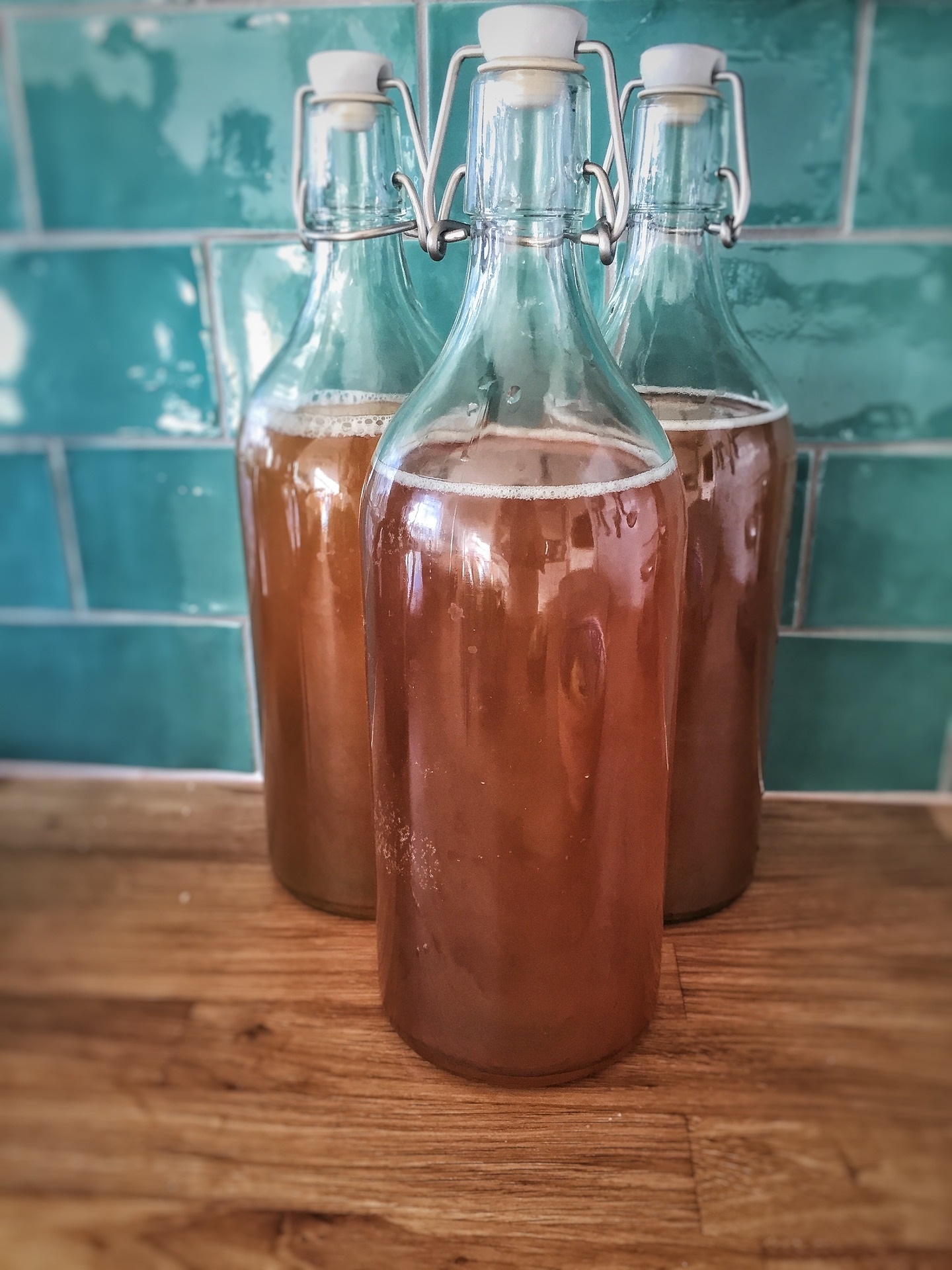
By: Rise Morisato, CSUN Dietetic Intern
Over the past few years, kombucha has risen in popularity in the United States and is more commonly seen on the shelves of our favorite stores. But what is kombucha?
Kombucha is a beverage produced through the fermentation of black or green tea and sugar with bacteria and yeast. The word “kombucha” is thought to have originated when Dr. Kombu brought the drink to cure the Japanese emperor of his digestive ailments, thus gaining the name “kombu” meaning seaweed, and “cha” meaning tea.1 However, kombucha is known throughout the world by many different names including: red tea fungus, Champignon de longue vie, Chainii grib, Ling zhi, kocha kinoko, and Chainii kvass.2 Kombucha is believed to have originated in China over 2000 years ago during the Tsin Dynasty, where the beverage was prized for its detoxifying and energizing properties.1 However, through the help of merchants, the beverage was able to make its way throughout Europe and the Middle East.2 The fermentation process is usually carried out for 7-10 days in household settings using a tea fungus and ultimately produces a refreshing beverage reminiscent of sparkling apple cider.1,2
Fermentation is the slow, controlled decomposition of organic substances by microorganisms or enzymes. It converts sugars into acids, alcohols, and carbon dioxide, which are beneficial for health and culinary purposes. Fermentation enhances nutrients, removes anti-nutrients, contains probiotic bacteria, and inhibits the growth of foodborne pathogens. Another added benefit of fermentation is its ability to produce desirable tastes and textures that can help to increase the acceptability of a wider variety of foods.3 Some research is showing that consuming fermented foods is associated with better lipid panels, improved glucose tolerance, and improved digestive function.3 Furthermore, given that fermented foods contain anywhere between 1 million to 1 billion microbes per gram or milliliter, eating fermented foods can significantly increase the number of microbes present in our guts. While these microbes may only exhibit short-term effects in an individual’s native microbiota, they have demonstrated several beneficial effects, including improved brain and immune function.3
Kombucha contains a variety of compounds including organic acids, vitamins, minerals, antioxidants and lactic and acetic acid bacteria. All of these different compounds come together and contribute to this drink’s numerous health benefits. It has been shown that kombucha can efficiently aid in preventative healthcare and recovery due to four main properties: detoxification, anti-oxidation, energizing capabilities, and immunity promotion.4 Kombucha is believed to aid with digestion and can alter one’s gut bacteria by acting as a probiotic and balancing intestinal bacteria. It is also known to have the ability to improve the health of hair, skin, and nails, reduce stress and insomnia, and relieve headaches.5 Kombucha has been studied in relation to gastric illnesses, obesity, diabetes, cardiovascular disease, hypertension, liver and kidney diseases, joint problems, infectious diseases and cancer.4,5,6
Below is a recipe that can help you to create your own homemade kombucha. Although fermenting food at home is becoming an increasingly popular trend, it is important to do this process safely! Sanitation is critical and only sterile containers and utensils should be used. Sugar must be added for the microorganisms to grow; sucrose or table sugar is generally preferred. Only black or green tea should be used as the base. Herbal teas or other beverage bases should not be used. Finally, it is important to follow the proper steps of heating, cooling, and adding the starter. The fermentation process should take place at 68-72ºF for 7-10 days, and it’s important to avoid fermenting in the sun, where the temperature can rise too high.7
Another benefit of making your own kombucha at home is your ability to influence its flavor. The longer kombucha is allowed to ferment, the more acidic the taste.8 You can do a taste test at home by pouring a small amount on day seven to see if you like the taste. If it’s too sweet, let it ferment for a bit longer until it fits your desired taste!

Image: CookYourLife /Pixabay
Home-Brewed Kombucha Recipe by Amari Thomsen, MS, RD, LDN9
References:
- Dufresne C, Farnworth E. Tea, Kombucha, and health: a review. Food Research International. 2000;33(6):409-421. doi:10.1016/S0963-9969(00)00067-3
- Amarasinghe H, Weerakkody NS, Waisundara VY. Evaluation of physicochemical properties and antioxidant activities of kombucha “Tea Fungus” during extended periods of fermentation. Food Science & Nutrition. 2018;6(3):659-665. doi:10.1002/fsn3.605
- Dennett C. The Facts About Fermented Foods. Today’s Dietitian. https://www.todaysdietitian.com/newarchives/0418p24.shtml. Published April 2018. Accessed December 8, 2018.
- Vīna I, Semjonovs P, Linde R, Deniņa I. Current Evidence on Physiological Activity and Expected Health Effects of Kombucha Fermented Beverage. Journal of Medicinal Food. 2014;17(2):179-188. doi:10.1089/jmf.2013.0031
- Watawana MI, Jayawardena N, Gunawardhana CB, Waisundara VY. Health, Wellness, and Safety Aspects of the Consumption of Kombucha. Journal of Chemistry. 2015;2015:1-11. doi:10.1155/2015/591869
- Martínez Leal J, Valenzuela Suárez L, Jayabalan R, Huerta Oros J, Escalante-Aburto A. A review on health benefits of kombucha nutritional compounds and metabolites. CyTA – Journal of Food. 2018;16(1):390-399. doi:10.1080/19476337.2017.1410499
- Ingham B. Safe Preserving: Kombucha: What you need to know. Safe & Healthy: Preparing and Preserving Food at Home. https://fyi.uwex.edu/safepreserving/2014/06/03/safe-preserving-kombucha-what-you-need-to-know/. Accessed December 5, 2018.
- Orenstein BW. For Your Information: The Wonders of Kombucha Tea — Is it Healthful or Hazardous? Today’s Dietitian. https://www.todaysdietitian.com/newarchives/060415p20.shtml. Published June 2015. Accessed December 8, 2018.
- Thomsen A. How to Make Kombucha. Food & Nutrition Magazine. January 2014. https://foodandnutrition.org/blogs/stone-soup/how-to-make-kombucha/. Accessed December 8, 2018.
